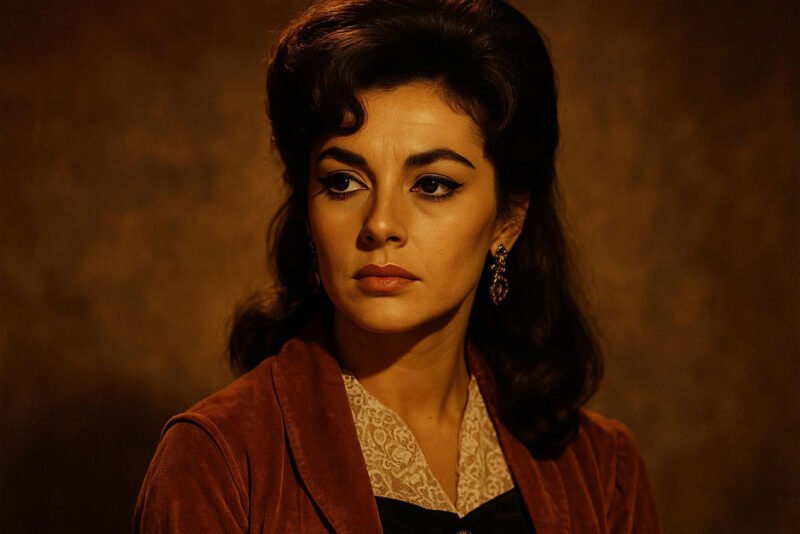When discussing influential Spanish actresses of the 1960s and 1970s, Diana Lorys stands out as a true icon of European cinema. Born Ana María Cazorla Vega in Madrid, this talented performer carved out an impressive career that spanned multiple decades and genres. Her transformation from a theater-trained artist to an international film star showcases the golden era of Spanish cinema.
Diana Lorys appeared in more than fifty films throughout her career, establishing herself as one of the most versatile actresses of her generation. Her work in spaghetti westerns, horror films, and adventure movies made her a recognizable face across European cinema. The Spanish actress became particularly known for her intense screen presence and ability to bring depth to every character she portrayed.
Early Life and Artistic Training
Born on October 20, 1940, in Madrid, Spain, Ana María Cazorla Vega grew up during a transformative period in Spanish history. Her family recognized her natural talent for performance early on, encouraging her to pursue formal training in the arts. This support would prove crucial in shaping her future success as Diana Lorys.
Her education covered multiple performance disciplines, creating a well-rounded foundation for her acting career. Classical ballet training gave her the elegant posture and graceful movement that became signature elements of her screen presence. She also studied Spanish flamenco, which connected her deeply to her cultural heritage while developing the passionate intensity that audiences would come to love.
Drama and diction classes completed her artistic education, providing essential skills for professional acting. These formative years taught her discipline and versatility that would set her apart from other performers. Her early theater work served as valuable preparation, allowing her to refine her craft before making the leap to film acting.
Rise to Fame in European Cinema
The year 1960 marked a pivotal moment in Diana Lorys’s career when she made her film debut in “Pelusa.” This transition from theater to cinema represented more than just a career change; it was the beginning of a new chapter in European film history. Her early performances caught the attention of directors and producers who recognized her unique screen presence and acting ability.
During her initial years in cinema, she appeared in various Spanish productions that showcased her range as a performer. Films like “Festival” and “Usted puede ser un asesino” demonstrated her ability to handle different genres and character types. Her performances were marked by a natural charisma that translated well to the big screen, earning her recognition within the Spanish film industry.
The actress’s reputation grew steadily as she took on more challenging roles and worked with established directors. Her dedication to her craft was evident in every performance, whether she was playing a dramatic lead or a supporting character. This period established her as a reliable and talented actress who could elevate any production with her presence.
The Spaghetti Western Era
The Euro-western genre proved to be Diana Lorys’s perfect showcase, where her striking appearance and commanding screen presence found their ideal home. She starred in seventeen western productions, becoming one of the most memorable faces of the spaghetti western movement. These films established her international reputation and secured her place in cinema history.
Her 1964 performance in “Gunfighters of Casa Grande” marked a significant breakthrough in the western genre. Playing the character Gitana, she demonstrated her natural ability to embody strong, complex female characters. The film highlighted her talent for bringing authenticity and emotional depth to her roles, qualities that would define her western performances.
“The Texican” in 1966 elevated her status further, pairing her with established western stars in a major production. Her portrayal of Kit O’Neal proved she could hold her own alongside seasoned actors while bringing something unique to every scene. This success opened doors to more international collaborations and established her as a reliable draw for European western audiences.
The 1968 film “Villa Rides” represented the peak of her western career, featuring her in a high-budget production alongside major Hollywood names. Her role as Emilita showcased her ability to work seamlessly in international productions while maintaining the authentic presence that made her performances so compelling. The film’s commercial success demonstrated her broad appeal to audiences across different markets.
Horror and Genre Film Success
The horror genre provided Diana Lorys with some of her most memorable and challenging roles, beginning with her breakthrough performance in “The Awful Dr. Orloff” in 1962. This film marked her entry into the world of European horror cinema, where she would become a recognizable figure. Her dual role as Wanda Bronsky and Melissa demonstrated her range as an actress and her willingness to take on complex, demanding parts.
“Blue Eyes of the Broken Doll” in 1974 showcased her mature acting abilities and her continued relevance in the horror genre more than a decade into her career. Her portrayal of Claude was both haunting and sympathetic, displaying the emotional depth that set her apart from many of her contemporaries. The film’s success proved that she could evolve with changing audience tastes while maintaining her distinctive screen presence.
Her work in horror films often required her to portray characters caught between vulnerability and strength, a balance she managed with remarkable skill. These roles allowed her to explore darker themes and more complex psychological territory than many of her other films. Her performances in the horror genre contributed significantly to the development of European horror cinema during its golden age.
Career Evolution and International Recognition
Throughout the 1960s and 1970s, Diana Lorys expanded her repertoire to include spy films, science fiction, and adventure movies, demonstrating remarkable versatility as a performer. Her ability to adapt to different genres while maintaining her distinctive screen presence made her a valuable asset to producers working across various types of films. This period represented the height of her international recognition and commercial success.
Her work in Italian co-productions brought her to the attention of international audiences and established her as a truly European actress rather than simply a Spanish one. These collaborations allowed her to work with different directors, cinematographers, and fellow actors, enriching her artistic experience and broadening her appeal. The cross-cultural nature of these productions helped establish her reputation beyond Spanish-speaking markets.
The actress’s peak years coincided with a golden age of European genre filmmaking, when Spanish and Italian productions were gaining international recognition and commercial success. Her contributions to this movement were significant, as she helped establish the template for strong female characters in European genre films. Her performances during this period influenced a generation of actresses and filmmakers.
Later Career and Legacy
The decline of genre filmmaking in Spain during the late 1970s significantly impacted Diana Lorys’s career opportunities, as the industry that had nurtured her success began to change. Many of the production companies and directors who had been instrumental in her career moved on to other projects or left the industry entirely. This shift forced her to make difficult decisions about her professional future and personal life.
Her apparent retirement from film in 1978 marked the end of an era, though she remained connected to the performing arts through theater work in Germany during the late 1970s. This period of her life demonstrated her continued commitment to performance, even when film opportunities became scarce. Her work in German theater showed her adaptability and her dedication to her craft beyond the confines of her film career.
The surprise return to filmmaking in 2007 with “Un hombre de porvenir” provided a fitting coda to her remarkable career, even though the film received limited release. Her willingness to return to the screen after nearly three decades away demonstrated her enduring love for the medium that had made her famous. This final performance served as a reminder of her talent and her lasting connection to Spanish cinema.
Diana Lorys’s legacy extends far beyond her individual performances, encompassing her role in the development of European genre cinema and her influence on subsequent generations of actresses. Her career represents a bridge between the classical Hollywood tradition and the emerging European art film movement of the 1960s and 1970s. Her contributions to cinema continue to be recognized by film historians and enthusiasts who appreciate the golden age of European filmmaking.









